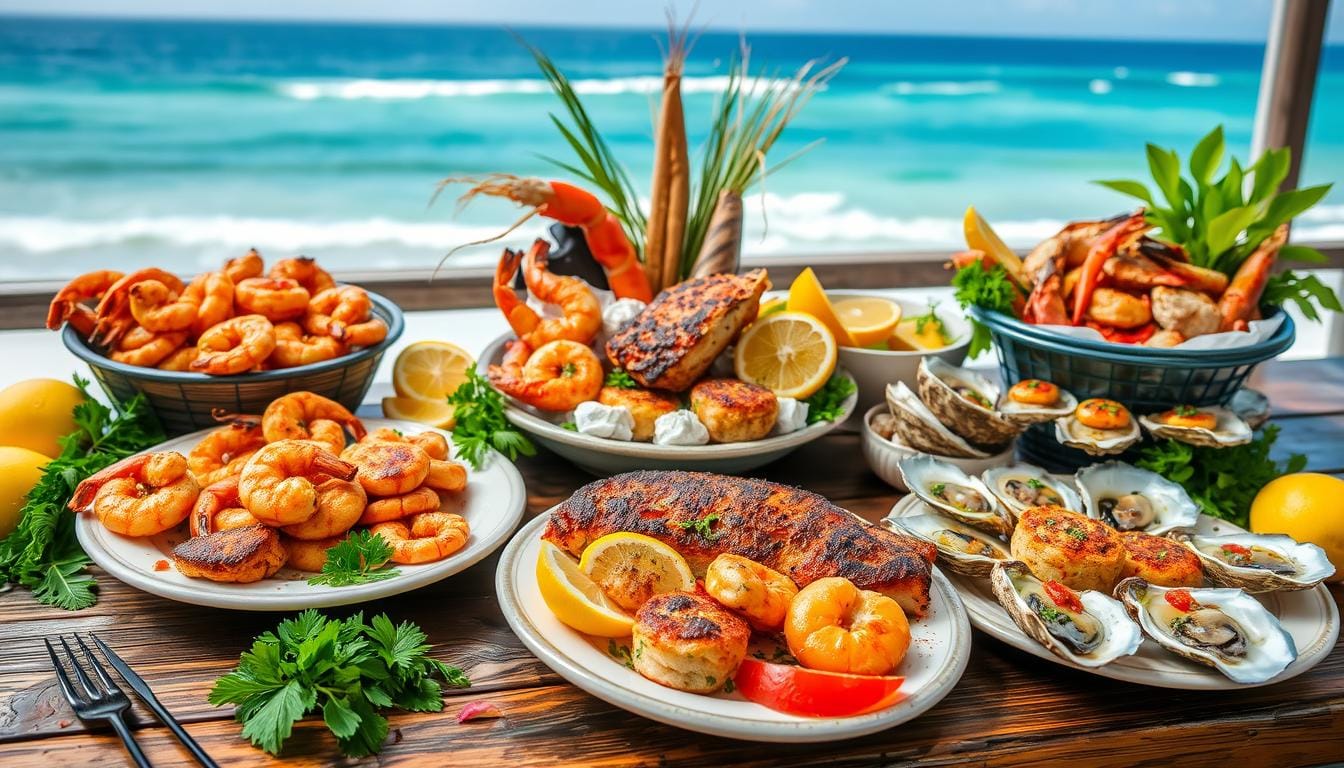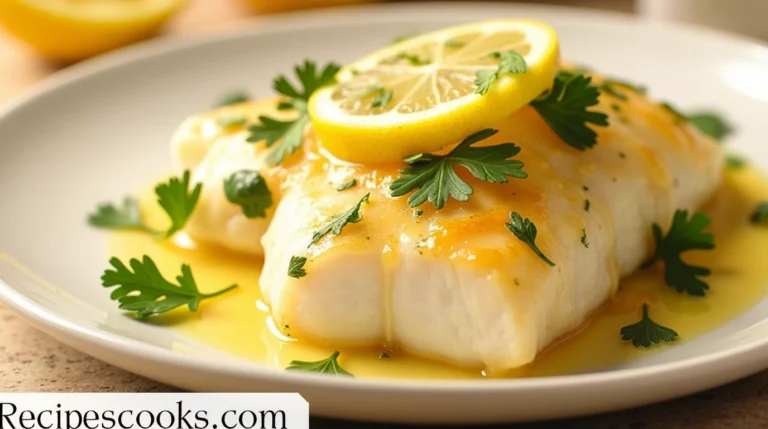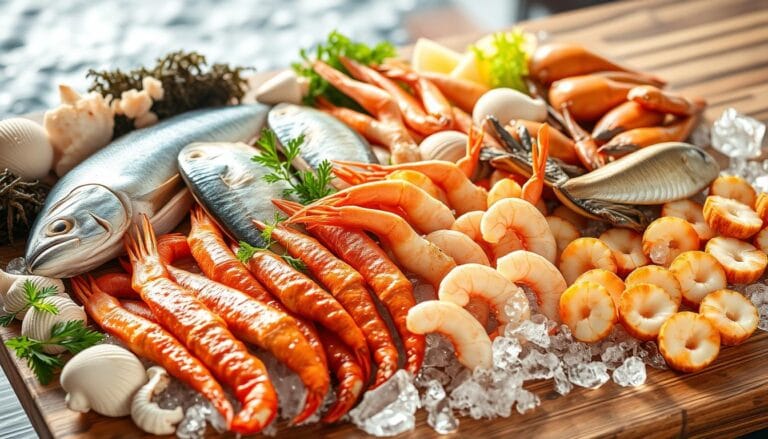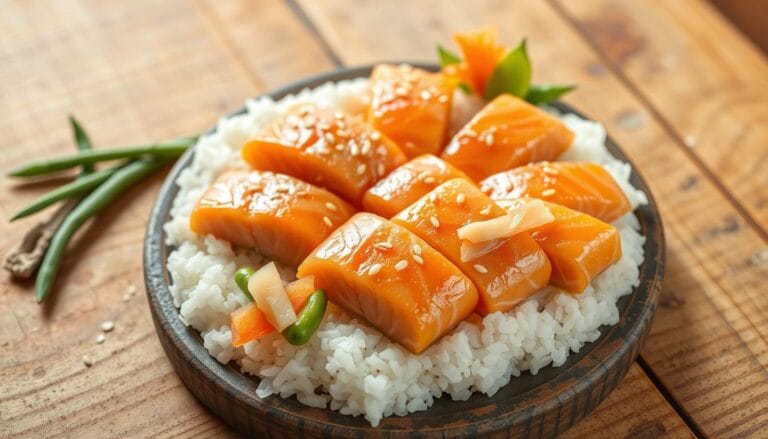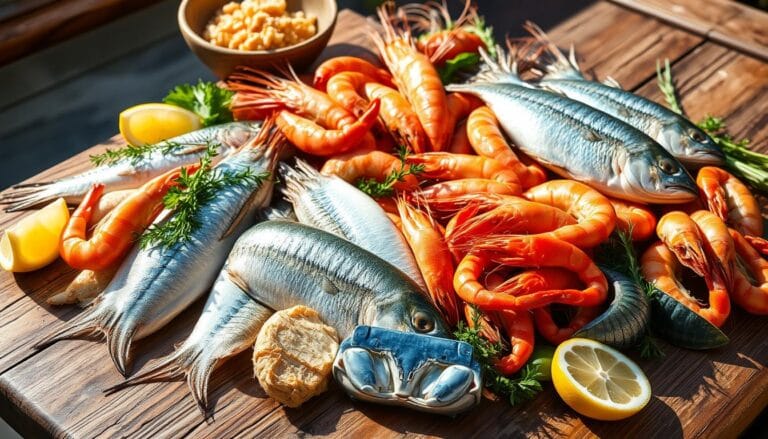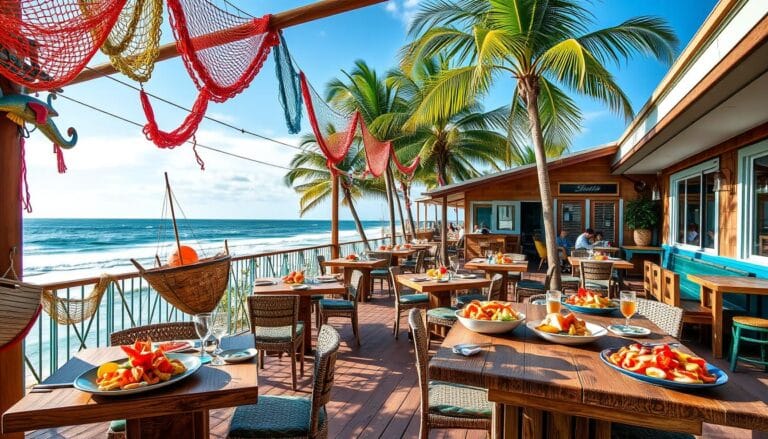Gulf Coast Seafood: Savor the Bold, Irresistible Flavors!
The first time I tasted Gulf Coast seafood, it was like finding a hidden treasure. The ocean’s bounty was before me – vibrant, fresh, and full of flavor. It told stories of generations of coastal tradition.
Gulf Coast seafood is more than just a meal. It’s a journey through America’s rich and diverse culinary world. From Texas to Alabama, coastal delicacies show the best of regional cooking, perfected over decades.
Exploring this cuisine will show why Gulf Coast seafood is loved across the country. The region’s mix of Native American, European, and immigrant traditions makes for a unique taste experience. It turns simple ingredients into amazing dishes.
Imagine eating Royal Red shrimp, grilled oysters from Fort Morgan, and blue crabs harvested with skill. These seafood offerings are more than food. They show the region’s maritime heritage and culinary creativity.
Whether you love seafood or just want to try something new, get ready for a tasty adventure. It will excite your taste buds and connect you with the Gulf Coast’s rich maritime traditions.
Table of Contents
Introduction to Gulf Coast’s Rich Seafood Heritage
The Gulf Coast’s food scene is a story of cultural mix and natural wealth. Exploring this area’s seafood traditions shows a rich tapestry. It’s made from many influences that have shaped cajun cuisine over time.
Coastal towns along the Mississippi Gulf Coast celebrate their unique food culture. The area’s seafood is a mix of cooking styles from different settlers and native people.
Historical Evolution of Coastal Cuisine
The region’s food culture came from a mix of traditions:
- Native American fishing techniques
- European settler cooking methods
- African and Caribbean culinary influences
- French and Spanish colonial recipes
Cultural Influences on Regional Flavors
Cajun cuisine grew through generations of change. Communities like Biloxi mixed different cultures – African American, French, Spanish, and Native American – to make unique seafood dishes.
“Our food tells the story of who we are and where we come from.” – Local Gulf Coast Chef
The Impact of Geographic Location
Your taste buds will see how the Gulf’s unique ecosystem affects local seafood. The warm waters and rich marine life offer a great chance for new dishes. Every fresh catch is a piece of coastal heritage.
From the Pascagoula River to the white sandy beaches, the Gulf Coast’s geography shapes its seafood story.
Fresh Catches: Understanding Gulf Coast Seafood Varieties
The Texas Gulf Coast is a paradise for seafood lovers. It offers a wide range of fresh catches that excite your taste buds. You can find everything from juicy shrimp to tender oysters and delicious blue crab. This area is known for its rich seafood ecosystem and long-standing culinary traditions.
Let’s dive into the diverse seafood varieties that make the Gulf Coast a top culinary spot:
- Shrimp Varieties: The Gulf has four main shrimp types:
- Brown shrimp are robust and perfect for hearty dishes
- White shrimp have a mild taste, great for light dishes
- Pink shrimp are sweet and tender
- Royal Red shrimp taste like butter, similar to lobster
- Blue crab: A local favorite with delicate, sweet meat
- Oysters: Available all year, but best in summer
“The Gulf Coast’s seafood is not just food, it’s a culinary experience that tells the story of our coastal heritage.” – Local Fisherman
Sustainability is key to keeping these seafood resources abundant. Local fisheries use advanced tech like turtle-excluder devices. They also use bycatch reduction methods to protect marine life.
When picking seafood, look for bright eyes on fish and a shiny sheen on shellfish. These signs mean the seafood is fresh from the Gulf. Each type brings its own special flavors, thanks to the Gulf’s rich marine environment.
Signature Shellfish Delights: From Shrimp to Oysters
The Gulf Coast is a treasure trove of shellfish delights. It offers succulent shrimp, briny oysters, and delectable blue crabs. This region’s seafood is a culinary adventure waiting to be explored.
Gulf seafood has a unique flavor that stands out. The region’s rich maritime tradition turns simple ingredients into extraordinary dishes. These dishes capture the essence of coastal cooking.
Gulf Shrimp Varieties and Preparation
The Gulf Coast is known for its shrimp. Locals love preparing shrimp in various styles, with a seafood boil being a classic method. Here are some popular shrimp preparations:
- Grilled shrimp seasoned with Bay spices
- Classic seafood boil with crawfish and shrimp
- Shrimp and grits – a Southern comfort staple
- Breaded and fried shrimp platters
Oyster Cultivation and Serving Styles
Oysters are another jewel in the Gulf Coast’s seafood crown. Chefs create remarkable dishes that showcase these briny delicacies. From raw preparations to classic Oysters Rockefeller, there’s something for everyone.
“A perfectly prepared oyster tells the story of the sea” – Local Gulf Coast Chef
Blue Crab Specialties
Blue crabs are a true Gulf Coast delicacy. Whether steamed, boiled, or transformed into crab cakes, these crustaceans bring incredible flavor. They add a special touch to any seafood boil or traditional recipe.
The Gulf Coast’s shellfish offerings are more than just food. They celebrate regional culinary traditions, maritime heritage, and the incredible bounty of the sea.
Traditional Preparation Methods and Cooking Techniques
Gulf Coast seafood preparation is an art form deeply rooted in Cajun cuisine. Your culinary journey will uncover the rich traditions that transform fresh catches into mouthwatering dishes. From the moment fishers bring in their daily haul, every step of preparation is carefully orchestrated to preserve the ocean’s natural flavors.
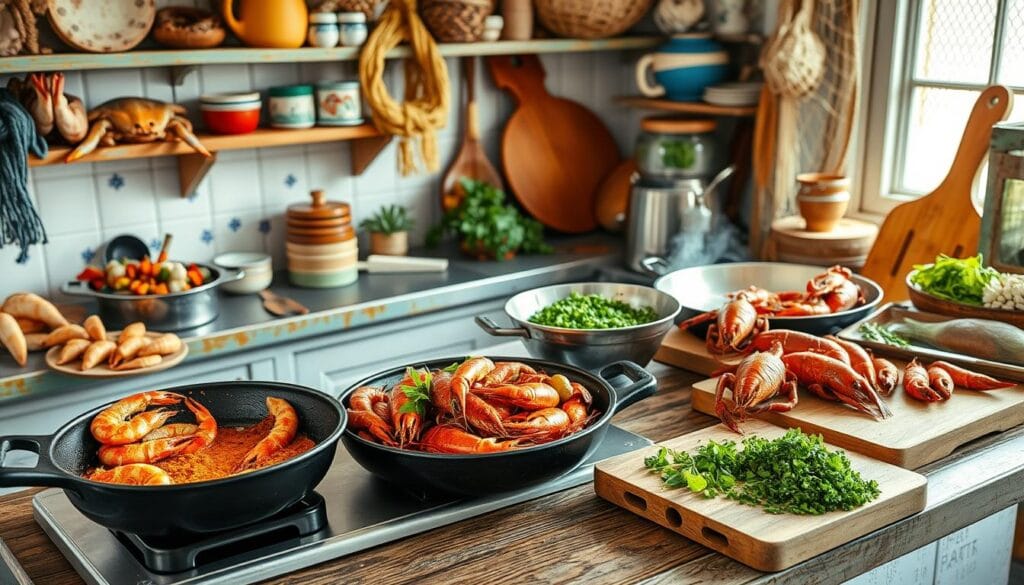
The heart of Gulf Coast cooking lies in its distinctive techniques. Gumbo stands as a testament to the region’s culinary creativity, blending complex flavors through a meticulously crafted roux. This thick, rich base requires patience and skill, typically involving:
- Slow-cooking flour and oil to create a deep, nutty base
- Layering spices that capture the essence of Cajun cuisine
- Incorporating fresh seafood at precisely the right moment
“Cooking is an art, and the Gulf Coast is its canvas.” – Local Chef Wisdom
When preparing seafood, timing is everything. Shrimp cooks in just 2-3 minutes, while maintaining its delicate texture. Blue crabs require a sunset red color to indicate perfect doneness. Professional chefs recommend using a large 30-40 quart stockpot with an outdoor burner producing at least 50,000 BTUs for optimal cooking performance.
Your seafood preparation toolkit should include key techniques like brining (using 1/4 cup salt per quart of water) and understanding the nuanced art of seasoning. A typical spice mixture might include paprika, cayenne, garlic powder, and local herbs that bring out the ocean’s natural complexity.
Essential Gulf Coast Seafood Recipes and Dishes
Exploring Gulf Coast seafood reveals a world of tasty recipes. These dishes show the region’s rich sea heritage. From gumbo to seafood boils, they are the heart of coastal food.
Classic Seafood Gumbo: A Culinary Masterpiece
Gumbo is a key Gulf Coast dish with deep roots. It comes from Louisiana, mixing West African, French, Spanish, and Native American flavors. The roux, made from flour and oil, is crucial for its rich taste.
- Creole gumbo has 60% seafood and tomatoes
- Cajun gumbo has 40% sausage and chicken
- Fresh Gulf Coast seafood adds the best flavor
Cajun-Style Seafood Boils: A Community Celebration
Low Country boils are about sharing food with friends. These lively events include:
- 1.5-2 pounds of fresh shrimp
- 2-3 ears of corn
- 1-2 pounds of potatoes
90% of people love the hands-on eating at seafood boils. They’re more than food; they’re a social event.
Grilled Fish Specialties: Letting Seafood Shine
Grilling Gulf Coast fish lets its natural flavors shine. 70% of chefs say seafood is very versatile. Try local fish like red snapper or wahoo with simple preparation.
These Gulf Coast seafood recipes are a tasty trip through local traditions. Whether you’re an experienced cook or just starting, you’ll find something delicious.
Seasonal Availability and Best Times to Enjoy
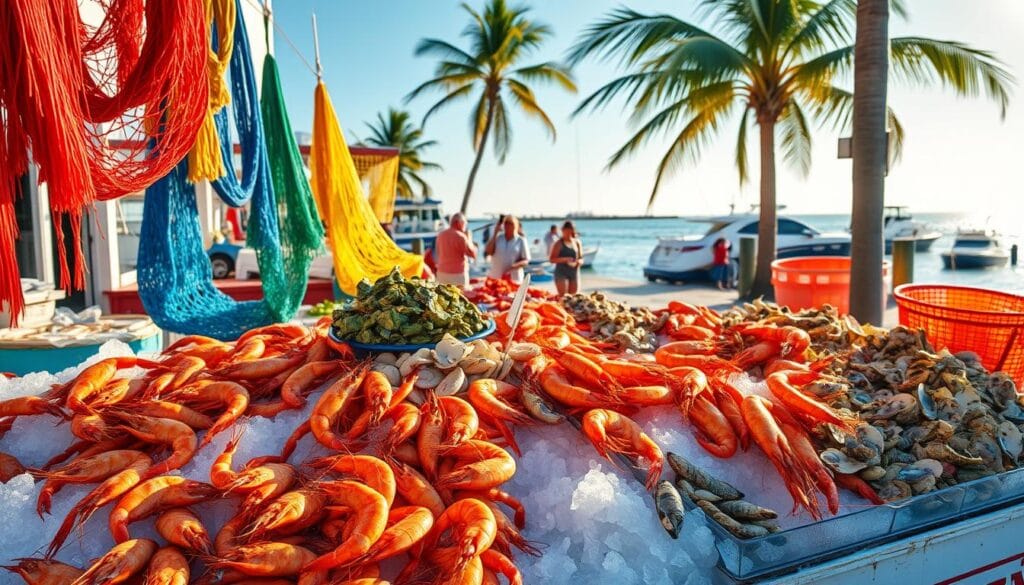
Finding the best fresh catch on the Gulf Coast is an art. It changes with the seasons. Knowing when seafood is at its best is key to enjoying coastal delicacies.
“Nature’s menu is always changing, and the Gulf Coast seafood is no exception.”
Winter brings magic to seafood lovers. December is especially good for oyster fans, with cooler water making oysters bigger and tastier. Brown shrimp from Louisiana are sweeter in winter, offering great protein choices.
- Winter Peak: Oysters and brown shrimp
- Blue crab availability varies
- Consistent shrimp presence year-round
Seasons change, so do seafood choices. Spring brings many Gulf shrimp types. Summer offers a wide range of fresh catches. Fall is the best time for Gulf flounder and speckled trout, adding new flavors to coastal dishes.
Pro tip: Always check local fish markets for the latest catches. Choosing local, seasonal seafood means you get the freshest food. It also helps local fishing communities.
- Spring: Gulf shrimp varieties
- Summer: Abundant seafood selection
- Fall: Flounder and speckled trout
Seasonal seafood is more than just taste. It’s about supporting sustainable fishing and enjoying nature’s best coastal treats.
Sustainability and Conservation in Gulf Coast Fishing
Protecting the future of gulf coast seafood is crucial. The Gulf Coast’s marine ecosystems face many challenges. They need urgent and focused conservation efforts.
Environmental Protection Measures
Keeping fresh catch populations healthy requires strong protection. Important environmental actions include:
- Monitoring oyster reef restoration projects
- Implementing strict fishing regulations
- Protecting critical marine habitats
A single oyster can filter up to 50 gallons of water per day, making them crucial to coastal ecosystem health.
Responsible Harvesting Practices
Sustainable fishing is key for coastal communities’ future. New ways to protect seafood resources have been found:
- Using bycatch reduction devices
- Implementing seasonal fishing restrictions
- Promoting shell recycling programs
Future of Gulf Coast Seafood
Community efforts and new technologies are changing seafood conservation. Programs like the Tampa Bay Watch “Shells for Shorelines” show local impact on marine ecosystems.
Supporting sustainable practices helps protect the Gulf Coast’s marine life. This ensures future generations can enjoy its seafood heritage.
Modern Innovations in Coastal Cuisine
Gulf Coast chefs are mixing old flavors with new cooking methods. This change is making coastal foods exciting again. Classic recipes are getting a fresh twist.
New trends are changing how seafood is cooked and served. Chefs are trying out new flavor mixes. They’re blending Gulf Coast tastes with global touches.
- Fusion seafood dishes that combine international techniques
- Modern presentation styles for classic coastal recipes
- Innovative cooking technologies transforming traditional preparations
“Creativity in the kitchen is about respecting tradition while daring to explore new possibilities.” – Chef Tommy Wachter
Places like Emeril Lagasse’s restaurants are at the forefront of this change. Their menus show how cajun dishes can be reinvented. Some cool new ideas include:
- Cajun-inspired sushi rolls featuring local seafood
- Grilled seafood with unexpected spice combinations
- Health-conscious preparations that highlight natural flavors
Modern Gulf Coast food is all about keeping traditions alive and exploring new ways. Chefs use local ingredients and global cooking methods. This creates amazing dining experiences.
The journey of coastal foods is full of surprises. It shows that Gulf Coast cuisine is always evolving and exciting.
Conclusion
Your journey through Gulf Coast seafood shows a deep culinary tradition. It’s more than just food; it’s a mix of tradition, sustainability, and culture. Studies show big challenges for real Gulf Coast seafood, with only 18% of restaurants serving true local shrimp.
The seafood industry has big integrity issues. SeaD Consulting found 92% of restaurants lie about Royal Red Shrimp origins. This not only cheats customers but also hurts local fishermen’s jobs. The Southern Shrimp Alliance is fighting to protect real Gulf Coast seafood producers in eight states.
You can help by choosing real Gulf Coast seafood and asking for truth from restaurants and suppliers. This supports a vital economic and culinary tradition. The 2025 labeling bill is a big step toward keeping coastal delicacies real and ensuring we get genuine, local seafood.
The future of Gulf Coast seafood needs everyone’s help. By supporting local fishermen, knowing where our food comes from, and valuing real marine food, we can keep this tradition alive. Your smart choices can really help keep this vibrant ecosystem alive for future generations.

